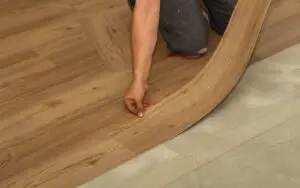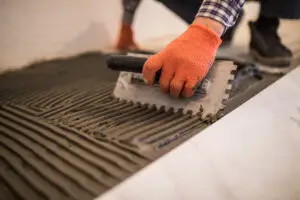Understanding Carpet Installation on Concrete
What to Consider Before Installing Carpet on Concrete
Moisture Levels
One of the most important factors to consider before installing carpet on concrete, is the moisture level. Concrete is a porous material, and can easily absorb moisture from the ground, or the surrounding air. High moisture levels can lead to mold growth, mildew, and damage to the carpet, and also to the subfloor itself. It is always essential to perform a moisture test, to determine if a moisture barrier is needed.
Subfloor Condition
The condition of the concrete subfloor is also essential for a successful carpet installation. The subfloor should be level, clean, and free of any cracks, or damage. Any imperfections in the subfloor can telegraph through the carpet, and cause it to wear unevenly, and will also shorten its lifespan. Professional installers will always inspect the subfloor, and take the necessary steps to ensure that it is ready for the new carpet.
Building Codes
It is also important to check your local building codes, to ensure that you are following all of the requirements for carpet installation on concrete. Some areas may require permits, or inspections, and it is essential to comply with all of the local regulations. Professional installers are always familiar with all of the local regulations, and can make sure that you are compliant with all of the rules, and guidelines.
Potential Problems with Direct Installation
Moisture Issues
Installing carpet directly on concrete, without any type of moisture barrier, or underlayment, can lead to significant moisture issues. Moisture can seep into the carpet, and create a breeding ground for mold and mildew, which will not only damage the carpet, but will also create an unhealthy living environment. This is one of the most common reasons for carpet failure, and should always be avoided.
Lack of Cushioning
Installing carpet directly on concrete will also result in a lack of cushioning, which can make the floor uncomfortable to walk on, and can also cause premature wear and tear to the carpet fibers. Proper cushioning, provides extra comfort, helps to insulate the floor, and can also help to reduce noise. For these reasons, professional installers will always recommend the use of underlayment, and will also provide you with options that will fit your budget.
Reduced Lifespan
Installing carpet directly on concrete will almost always result in a reduced lifespan for the carpet. The lack of cushioning, and the potential for moisture damage, will cause the carpet to wear out more quickly, and will also result in the need for more frequent replacements. It is usually well worth the extra expense, to follow the proper techniques, and ensure that your floors will last for as long as possible.
Preparing Concrete for Carpet Installation
Moisture Testing
Calcium Chloride Test
The calcium chloride test is a common method for measuring the amount of moisture that is being released from the concrete. This test involves placing a container of calcium chloride on the concrete, sealing it, and then measuring the amount of moisture that the calcium chloride absorbs over a period of time. The results of this test will help determine if a moisture barrier is needed.
Relative Humidity Test
The relative humidity test measures the humidity levels within the concrete, using a special probe. This test can provide a more accurate measurement of the moisture content, and will help determine if there are any potential moisture issues that need to be addressed. This test is usually performed by a professional installer, who has specialized tools, and experience.
Subfloor Preparation
Cleaning and Leveling
The concrete subfloor must be thoroughly cleaned, and leveled, before any carpet is installed. This will involve removing any dirt, dust, debris, and adhesives, and patching any cracks or holes. It is also important to ensure that the subfloor is as level as possible, to prevent any unevenness in the carpet.
Crack Repair
Any cracks in the concrete subfloor should be repaired before installing carpet, to prevent them from spreading, and causing further damage. There are a variety of products that can be used to repair cracks in concrete, such as patching compounds, and epoxy fillers. A professional installer can help you to decide which is the best option for your specific situation.
Importance of Underlayment
Types of Underlayment
There are a variety of different types of underlayment that can be used for carpet installation on concrete, including foam, rubber, and felt. The type of underlayment you choose will depend on your specific needs and budget, and also on the type of carpet that you are planning to install.
Benefits of Underlayment
Underlayment provides a number of benefits, including cushioning, sound insulation, moisture protection, and an increased lifespan for your carpet. It is always recommended to use underlayment, when installing carpet on concrete, to help ensure a long-lasting, and comfortable floor. Professional installers are always very familiar with the benefits of all of these methods, and will be able to guide you through the process.
Alternative Installation Methods
Using a Moisture Barrier
Types of Barriers
There are several types of moisture barriers that can be used to protect carpet from moisture, when installed on concrete, including plastic sheeting, and liquid-applied membranes. Plastic sheeting is a simple and cost-effective option, while liquid-applied membranes provide a more seamless, and durable barrier.
Installation Process
The installation process for a moisture barrier typically involves cleaning the concrete, applying the barrier, and then sealing the seams, and edges, to prevent any moisture from seeping through. It is important to follow the manufacturer’s instructions carefully, to ensure that the barrier is properly installed.
Raised Subfloor Systems
Advantages
Raised subfloor systems provide a number of advantages, including moisture protection, improved insulation, and a more comfortable walking surface. These systems create a gap between the concrete, and the carpet, which allows for better air circulation, and helps to prevent moisture buildup.
Cost Considerations
Raised subfloor systems can be more expensive than other installation methods, due to the cost of the materials, and the labor required for installation. However, they can also provide long-term benefits, by improving the comfort and energy efficiency of your home, and helping to prolong the life of your floors.
DIY vs Professional Carpet Installation on Concrete
Challenges of DIY
Potential for Mistakes
DIY carpet installation on concrete, comes with many potential problems and challenges, such as improper subfloor preparation, incorrect measurements, and inadequate moisture protection. These errors can lead to a poor installation, that may need to be corrected by a professional installer, in the future.
Tool Requirements
DIY carpet installation also requires specialized tools, such as a knee kicker, power stretcher, and carpet trimmer, which will all add to the overall cost of the project. If you do not know how to properly use these tools, you also run the risk of damaging the carpet, or injuring yourself.
Benefits of Professional Services
Expertise and Experience
Professional carpet installers have the expertise and experience needed, to ensure a successful, and long-lasting installation on concrete. They are familiar with all of the best practices for moisture protection, subfloor preparation, and carpet installation, and will use their knowledge to ensure that your project is a success.
Warranty and Guarantee
Professional carpet installation services often offer warranties, and guarantees, on their work, which will provide you with peace of mind, knowing that you are protected from any unexpected problems or issues that may arise after the installation is completed. This type of protection is not available with DIY installs.
Case Studies: Concrete Carpet Success
Example of Proper Install
A homeowner hired a professional installer, to install carpet in their basement, which had a concrete subfloor. The installer performed a moisture test, installed a moisture barrier, properly prepared the subfloor, and used all of the proper installation techniques, which resulted in a warm, comfortable, and dry basement, that the homeowner was able to enjoy for many years.
Example of Moisture Problems
Another homeowner attempted to install carpet directly on a concrete subfloor in their basement, without taking any precautions. After just a few years, the carpet developed mold and mildew, and the basement had a musty odor. The homeowner then had to hire a professional to remove the carpet, treat the mold, and install a proper flooring system, which ended up costing much more than if they had hired a professional to begin with.
FAQs & Answers
It is generally not recommended to install carpet directly on concrete, due to potential moisture issues, and the lack of cushioning. It is always important to take the necessary steps, such as moisture testing, and subfloor preparation, before any new carpet is installed. Professional installers are familiar with all of these steps, and will always ensure that the job is done correctly, for a long-lasting and durable result.
The primary concerns regarding moisture, when installing carpet on a concrete subfloor, are the potential for mold growth, mildew, and damage to the carpet and subfloor. Concrete is naturally porous, and can easily absorb moisture from the ground, or from the air. This can lead to a variety of problems if the proper steps are not taken. Professional installers are always very aware of these types of moisture problems, and know how to prevent them from happening.
Common methods for testing moisture levels in a concrete subfloor include the calcium chloride test, and the relative humidity test. These tests will measure the amount of moisture that is present in the concrete, and will help determine if a moisture barrier is needed. Professional installers have all of the tools and knowledge to perform these types of tests, and can accurately assess the results.
When installing carpet on a concrete subfloor, it is best to use an underlayment with a built-in moisture barrier. This will help to prevent moisture from seeping into the carpet, and causing mold, mildew, or other damage. Professional installers can recommend the best types of underlayment for your specific situation, and will also ensure that it is installed correctly, and effectively.
Professional carpet installers can help ensure a successful and long-lasting installation on a concrete subfloor, by performing moisture testing, preparing the subfloor properly, using the right underlayment, and following all of the industry best practices. They can also offer warranties on their work, which will give you added peace of mind, and will protect you from any unexpected problems or expenses.





